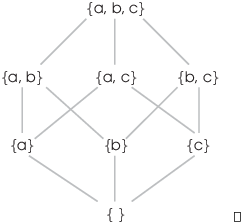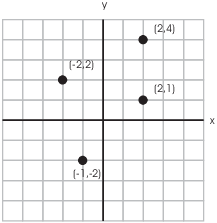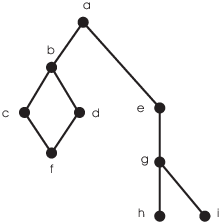A partial order on a set is, roughly speaking,
a relation that behaves like the relation ![]() on
on ![]() .
.
Definition. Let X be a set, and let ![]() be a relation on X.
be a relation on X. ![]() is a
partial order if:
is a
partial order if:
(a) (Reflexive) For all ![]() ,
, ![]() .
.
(b) (Antisymmetric) For all ![]() , if
, if ![]() and
and ![]() , then
, then ![]() .
.
(c) (Transitive) For all ![]() , if
, if ![]() and
and ![]() , then
, then ![]() .
.
Example. For each relation, check each axiom for a partial order. If the axiom holds, prove it. If the axiom does not hold, give a specific counterexample.
(a) The relation ![]() on
on ![]() .
.
(b) The relation ![]() on
on ![]() .
.
(a) For all ![]() ,
, ![]() : Reflexivity
holds.
: Reflexivity
holds.
For all ![]() , if
, if ![]() and
and ![]() , then
, then ![]() : Antisymmetry holds.
: Antisymmetry holds.
For all ![]() , if
, if ![]() and
and ![]() , then
, then ![]() : Transitivity holds.
: Transitivity holds.
Thus, ![]() is a partial order.
is a partial order.![]()
(b) For no x is it true that ![]() , so reflexivity fails.
, so reflexivity fails.
Antisymmetry would say: If ![]() and
and ![]() , then
, then ![]() . However, for no
. However, for no ![]() is it true that
is it true that ![]() and
and ![]() . Therefore, the first part of the conditional is
false, and the conditional is true. Thus, antisymmetry is
vacuously true.
. Therefore, the first part of the conditional is
false, and the conditional is true. Thus, antisymmetry is
vacuously true.
If ![]() and
and ![]() , then
, then ![]() . Therefore, transitivity holds.
. Therefore, transitivity holds.
Hence, ![]() is not a partial order.
is not a partial order.![]()
Example. Let X be a set and let ![]() be the power set of X --- i.e. the set of all subsets
of X. Show that the relation of set inclusion
is a partial order on
be the power set of X --- i.e. the set of all subsets
of X. Show that the relation of set inclusion
is a partial order on ![]() .
.
Subsets A and B of X are related under set inclusion if ![]() .
.
If ![]() , then
, then ![]() . The relation
is reflexive.
. The relation
is reflexive.
Suppose ![]() . If
. If ![]() and
and ![]() , then by definition of set
equality,
, then by definition of set
equality, ![]() . The relation is symmetric.
. The relation is symmetric.
Finally, suppose ![]() . If
. If ![]() and
and ![]() , then
, then ![]() . (You can write out the easy proof using elements.)
The relation is transitive.
. (You can write out the easy proof using elements.)
The relation is transitive.
Here's a particular example. Let ![]() . This is
a picture of the set inclusion relation on
. This is
a picture of the set inclusion relation on ![]() :
:

Definition. Let ![]() be a partially ordered set. The
lexicographic order (or dictionary order)
on
be a partially ordered set. The
lexicographic order (or dictionary order)
on ![]() is defined as follows:
is defined as follows: ![]() means that
means that
(a) ![]() , or
, or
(b) ![]() and
and ![]() .
.
Note that ![]() implies
implies ![]() .
.
You can extend the definition to two different partially ordered sets
X and Y, or a sequence ![]() ,
, ![]() , ...,
, ..., ![]() of partially ordered sets in the same way. The name
dictionary order comes from the fact that it describes the
way words are ordered alphabetically in a dictionary. For instance,
"aardvark" comes before "banana" because
"a" comes before "b". If the first letters are
the same, as with "mystery" and "meat", then you
look at the second letters: "e" comes before "y",
so "meat" comes before "mystery".
of partially ordered sets in the same way. The name
dictionary order comes from the fact that it describes the
way words are ordered alphabetically in a dictionary. For instance,
"aardvark" comes before "banana" because
"a" comes before "b". If the first letters are
the same, as with "mystery" and "meat", then you
look at the second letters: "e" comes before "y",
so "meat" comes before "mystery".

In the picture above, ![]() , because
, because ![]() . And
. And ![]() because the
x-coordinates are equal and
because the
x-coordinates are equal and ![]() .
.
Proposition. The lexicographic order on ![]() is a partial order.
is a partial order.
Proof. First, ![]() , since
, since
![]() and
and ![]() .
. ![]() is reflexive.
is reflexive.
Next, suppose ![]() and
and ![]() . Now
. Now ![]() means that either
means that either ![]() or
or ![]() . The first case
. The first case ![]() is impossible, since this would contradict
is impossible, since this would contradict ![]() . Therefore,
. Therefore, ![]() . Then
. Then ![]() implies
implies
![]() and
and ![]() implies
implies ![]() . Hence,
. Hence, ![]() . Therefore,
. Therefore, ![]() .
.
![]() is antisymmetric.
is antisymmetric.
Finally, suppose ![]() and
and ![]() . To keep things organized, I'll
consider the four cases.
. To keep things organized, I'll
consider the four cases.
(a) If ![]() and
and ![]() , then
, then ![]() , so
, so ![]() .
.
(b) If ![]() and
and ![]() , then
, then ![]() , so
, so ![]() .
.
(c) If ![]() and
and ![]() , then
, then ![]() , so
, so ![]() .
.
(d) If ![]() and
and ![]() , then
, then ![]() and
and ![]() . This implies
. This implies ![]() and
and ![]() , so
, so ![]() .
.
Hence, ![]() is transitive, and this completes the proof
that
is transitive, and this completes the proof
that ![]() is a partial order.
is a partial order.![]()
A common mistake in working with partial orders --- and in real life --- consists of assuming that if you have two things, then one must be bigger than the other. When this is true about two things, the things are said to be comparable. However, in an arbitrary partially ordered set, some pairs of elements are comparable and some are not.
Definition. Let ![]() be a relation on a set X. x and y in X are comparable if either
be a relation on a set X. x and y in X are comparable if either ![]() or
or ![]() .
.
Here's a pictorial example to illustrate the idea. You can sometimes describe an order relation by drawing a graph like the one below:

This picture shows a relation ![]() on the set
on the set
![]()
Two elements are comparable if they're joining by a sequence of edges
that goes upward "without reversing direction". (Think of
"bigger" elements being above and "smaller"
elements being below.) It's also understood that every element
satisfies ![]() .
.
For example, ![]() , since there's an upward segment
connecting f to c. And
, since there's an upward segment
connecting f to c. And ![]() , since there's an upward path
of segments
, since there's an upward path
of segments ![]() connecting f to a.
connecting f to a.
On the other hand, there are elements which are not comparable. For
example, d and e are not comparable, because there is no upward path
of segments connecting one to the other. Likewise, ![]() and
and ![]() , but h and i are not
comparable.
, but h and i are not
comparable.
Notice that a is comparable to every element of the set, and that
![]() for all
for all ![]() .
.
Definition. Let X be a partially ordered set.
(a) An element ![]() which is comparable to every other
element of X and satisfies
which is comparable to every other
element of X and satisfies ![]() for all
for all ![]() is the largest element of the
set.
is the largest element of the
set.
(b) An element ![]() which is comparable to every other
element of X and satisfies
which is comparable to every other
element of X and satisfies ![]() for all
for all ![]() is the smallest element of the
set.
is the smallest element of the
set.
In some cases, we only care that an element be "bigger than" or "smaller than" elements to which it is comparable.
Definition. Let X be a partially ordered set.
If an element x satisfies ![]() for all y to which it is
comparable, then x is a maximal element.
Likewise, if an element x satisfies
for all y to which it is
comparable, then x is a maximal element.
Likewise, if an element x satisfies ![]() for all y to which
it is comparable, then x is a minimal element.
for all y to which
it is comparable, then x is a minimal element.
Note that a largest or smallest element, if it exists, is unique. On the other hand, there may be many maximal or minimal elements.
Example. Define a relation ![]() on
on ![]() by
by
![]()
Check each axiom for a partial order. If the axiom holds, prove it. If the axiom does not hold, give a specific counterexample.
![]() for all
for all ![]() , so
, so ![]() for all
for all ![]() . Therefore,
. Therefore, ![]() is reflexive.
is reflexive.
Suppose ![]() and
and ![]() . Is is true that
. Is is true that
![]() ?
?
![]() , since
, since ![]() . Likewise,
. Likewise, ![]() , since
, since ![]() . But
. But ![]() , so
, so ![]() is not antisymmetric.
is not antisymmetric.
Finally, suppose ![]() and
and ![]() . This means that
. This means that ![]() and
and ![]() . Hence,
. Hence, ![]() . Therefore,
. Therefore, ![]() , so
, so ![]() is transitive.
is transitive.![]()
Example. Define a relation ![]() on
on ![]() by
by
![]()
Check each axiom for a partial order. If the axiom holds, prove it. If the axiom does not hold, give a specific counterexample.
Since ![]() for all
for all ![]() , it follows that
, it follows that ![]() for all
for all ![]() .
Therefore,
.
Therefore, ![]() is reflexive.
is reflexive.
![]() , since
, since ![]() . Likewise,
. Likewise, ![]() , since
, since ![]() . However,
. However, ![]() .
Therefore,
.
Therefore, ![]() is not antisymmetric.
is not antisymmetric.
Finally, suppose ![]() and
and ![]() . Then
. Then ![]() and
and ![]() . Hence,
. Hence, ![]() .
Therefore,
.
Therefore, ![]() . Hence,
. Hence, ![]() is transitive.
is transitive.![]()
Definition. A relation ![]() on a set X is a total order
if:
on a set X is a total order
if:
(a) (Trichotomy) For all ![]() , exactly one of the
following holds:
, exactly one of the
following holds: ![]() ,
, ![]() , or
, or ![]() .
.
(b) (Transitivity) For all ![]() , if
, if ![]() and
and ![]() , then
, then ![]() .
.
The usual less than relation ![]() is a total order on
is a total order on ![]() , on
, on ![]() , and on
, and on ![]() . Likewise, you can use the total order relation on
. Likewise, you can use the total order relation on
![]() to define a lexicographic order on
to define a lexicographic order on ![]() which is a total order.
Specifically, define a total order
which is a total order.
Specifically, define a total order ![]() on
on ![]() as follows:
as follows: ![]() means that
means that
(a) ![]() , or
, or
(b) ![]() and
and ![]() .
.
You can check that the axioms for a total order hold.
Example. Consider the relation defined by the graph below:

Thus, ![]() means that
means that ![]() , and there is an upward path of segments from x to
y.
, and there is an upward path of segments from x to
y.
Is this relation a total order? You can check cases, using the picture, that the relation is transitive. (This amounts to saying that if there's an upward path from x to y and one from y to z, then there's such a path from x to z. In fact, if you define a relation using a graph in this way, the relation will be transitive.)
However, this graph does not define a total order. Trichotomy fails
for d and e, since ![]() ,
, ![]() , and
, and ![]() are all false.
are all false.![]()
Definition. Let S be a partially ordered set, and let T be a subset of S.
(a) ![]() is an upper bound
for T if
is an upper bound
for T if ![]() for all
for all ![]() .
.
(b) ![]() is a lower bound for
T if
is a lower bound for
T if ![]() for all
for all ![]() .
.
Thus, an upper bound for a subset is an element which is greater than or equal to everything in the subset; a lower bound for a subset is an element which is less than or equal to everything in the subset. Note that unlike the largest element or smallest element of a subset, upper and lower bounds don't need to belong to the subset.
For instance, consider the subset ![]() of
of ![]() . 2 is an upper bound for T, since
. 2 is an upper bound for T, since ![]() for all
for all ![]() . 1 is also an upper bound for
T. Note that 2 is not an element of T while 1 is an element of T. In
fact, any real number greater than or equal to 1 is an upper bound
for T.
. 1 is also an upper bound for
T. Note that 2 is not an element of T while 1 is an element of T. In
fact, any real number greater than or equal to 1 is an upper bound
for T.
Likewise, any real number less than or equal to 0 is a lower bound for T.
T has a largest element, namely 1. It does not have a smallest element; the obvious candidate 0 is not in T.
This example shows that a subset may have many --- even infinitely many --- upper or lower bounds. Among all the upper bounds for a set, there may be one which is smallest.
Definition. Let S be a partially ordered set,
and let T be a subset of S. An element ![]() is a least upper bound for T
if:
is a least upper bound for T
if:
(a) ![]() is an upper bound for T.
is an upper bound for T.
(b) If s is an upper bound for T, then ![]() .
.
The idea is that ![]() is an upper bound by (a); it's the
least upper bound, since (b) says
is an upper bound by (a); it's the
least upper bound, since (b) says ![]() is smaller than any other upper bound.
is smaller than any other upper bound.
Definition. Let S be a partially ordered set,
and let T be a subset of S. An element ![]() is a greatest lower bound for
T if:
is a greatest lower bound for
T if:
(a) ![]() is an lower bound for T.
is an lower bound for T.
(b) If s is an lower bound for T, then ![]() .
.
The concepts of least upper bound and greatest lower bound come up often in analysis. I'll give a simple example.
Example. Determine the least upper bound and greatest lower bound for the following sets (if they exist):
(a) The subset ![]() of
of ![]() .
.
(b) The subset ![]() of
of ![]() . (Thus, T is the positive real axis, not including
0.)
. (Thus, T is the positive real axis, not including
0.)
(a) Any real number greater than or equal to 1 is an upper bound for T. Among the upper bounds for S, it's clear that 1 is the smallest, so 1 is the least upper bound for S.
Likewise, any real number less than or equal to 0 is a lower bound for S. But among the lower bounds for S, it's clear that 0 is the largest, so 0 is the greatest lower bound for S.
Notice that ![]() , but
, but ![]() . The least upper bound and greatest lower bound may
be contained, or not contained, in the set.
. The least upper bound and greatest lower bound may
be contained, or not contained, in the set.![]()
(b) T has no least upper bound in ![]() ; in fact, T has no
upper bound in
; in fact, T has no
upper bound in ![]() .
.
0 is the greatest lower bound for T in ![]() .
.![]()
Copyright 2020 by Bruce Ikenaga